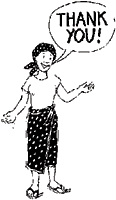This book is meant to be a resource book for milk producer groups and people working with these groups. It is a basket full of resources from which you can select the parts you feel are helpful to your group. The book is definitely not a 'blueprint' manual, because standard formulae for working with milk producer groups do not exist. Every group is different because the group members are different, as well as the group environment, cultural setting, government rules and regulations, etc.
The language used in this book is kept simple. Examples and illustrations are included for easy reference, the following symbols are used:
 indicates an
introduction to the chapter;
indicates an
introduction to the chapter;
 indicates
information sources at the end of the book;
indicates
information sources at the end of the book;
 indicates a 'real
life' example;
indicates a 'real
life' example;
 indicates a
participatory tool in chapter 6;
indicates a
participatory tool in chapter 6;
 indicates that steps
are described to complete a task.
indicates that steps
are described to complete a task.
The methods and tools described in this book are rough guidelines. It is hoped that it will support innovation and the adaptation of all methods and tools to your own situation. It is not necessary to read the book from the beginning to the end before you start. It intends to give suggestions which are grouped in chapters to facilitate access. Box 1 gives you a brief summary of each chapter.
Please feel free to contribute anything that you think is useful when working with milk producer groups!
|
BOX 1: A BRIEF EXPLANATION OF THE CHAPTERS chapter one: read this first! chapter two: forming groups chapter three: developing groups chapter four: milk collection, processing and
marketing chapter five: other group activities chapter six: participatory tools information sources and references glossary and index |
 This resource book is a result of the efforts of many people.
The key people who collaborated in the development of the ideas and tools in
this book are:
This resource book is a result of the efforts of many people.
The key people who collaborated in the development of the ideas and tools in
this book are:
OP Sinha (India), Ram Milan Upadhyay (Nepal) and Sudhir Chandra Das (Bangladesh), who all prepared a background document on the situation of milk producer groups in their respective countries; Joe Phelan who compiled these documents into a draft document on milk producer groups; Pat Francis, (Guyana) who greatly assisted during field trials of the participatory tools and the people at Milkvita and the Community Livestock and Dairy Development Project for their hospitality during field visits to Bangladesh.
Further thanks to Daniela Scicchigno, who produced the manuscript in desktop publishing and designed the layout, to Petra Röhr-Rouendaal for all the drawings in this book and to Tim Chamen for editing the text.
FAO colleagues Jean-Claude Lambert, Anthony Bennett, Paulina Couenberg and Masatsugu Okita provided useful comments to the draft. Last but not least thanks to Brian Dugdill of FAO who initiated and co-ordinated this activity.